transmission fluid CHEVROLET BLAZER 1995 2.G Owners Manual
[x] Cancel search | Manufacturer: CHEVROLET, Model Year: 1995, Model line: BLAZER, Model: CHEVROLET BLAZER 1995 2.GPages: 380, PDF Size: 20.04 MB
Page 94 of 380
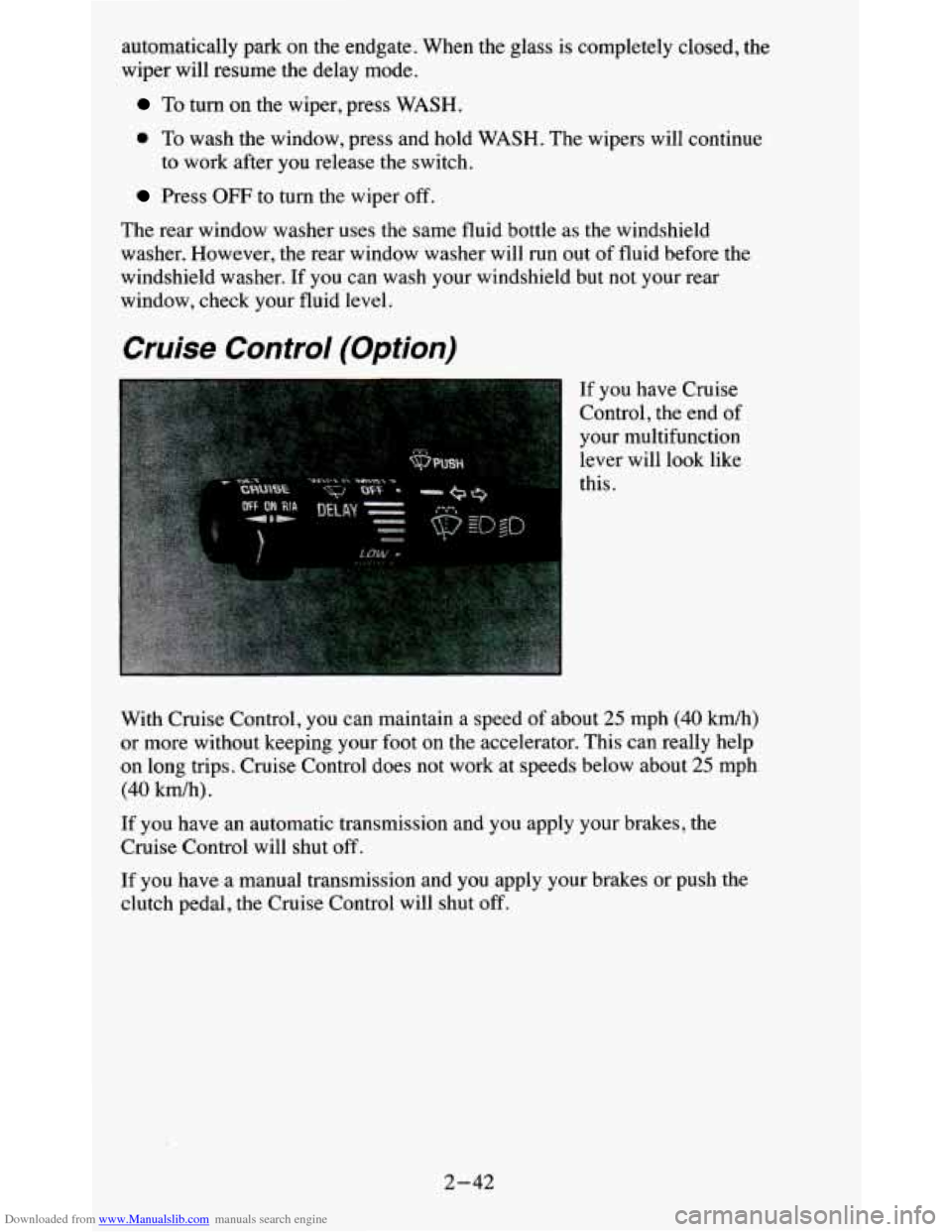
Downloaded from www.Manualslib.com manuals search engine automatically park on the endgate. When the glass is completely closed, the
wiper will resume the delay mode.
To turn on the wiper, press WASH.
a To wash the window, press and hold WASH. The wipers will continue
Press OFF to turn the wiper off.
to work after you release the switch.
The rear window washer uses the same fluid bottle as the windshield
washer. However, the rear window washer
will run out of fluid before the
windshield washer. If you can wash your windshield
but not your rear
window, check your fluid'level.
Cruise Control (Option)
- . .. ,. If you have Cruise
Control, the end of
your multifunction lever will look like
this.
With Cruise Control, you can maintain a speed of about
25 mph (40 kdh)
or more without keeping your foot on the accelerator. This can really help
on long trips. Cruise Control does not work at speeds below about
25 mph
(40 km/h).
If you have an auromatic tran .ission and you apply your brakes, the
Cruise Control will shut
off.
If you have a manual transmission and you apply your brakes or push the
clutch pedal, the Cruise Control will shut off.
2-42
Page 184 of 380
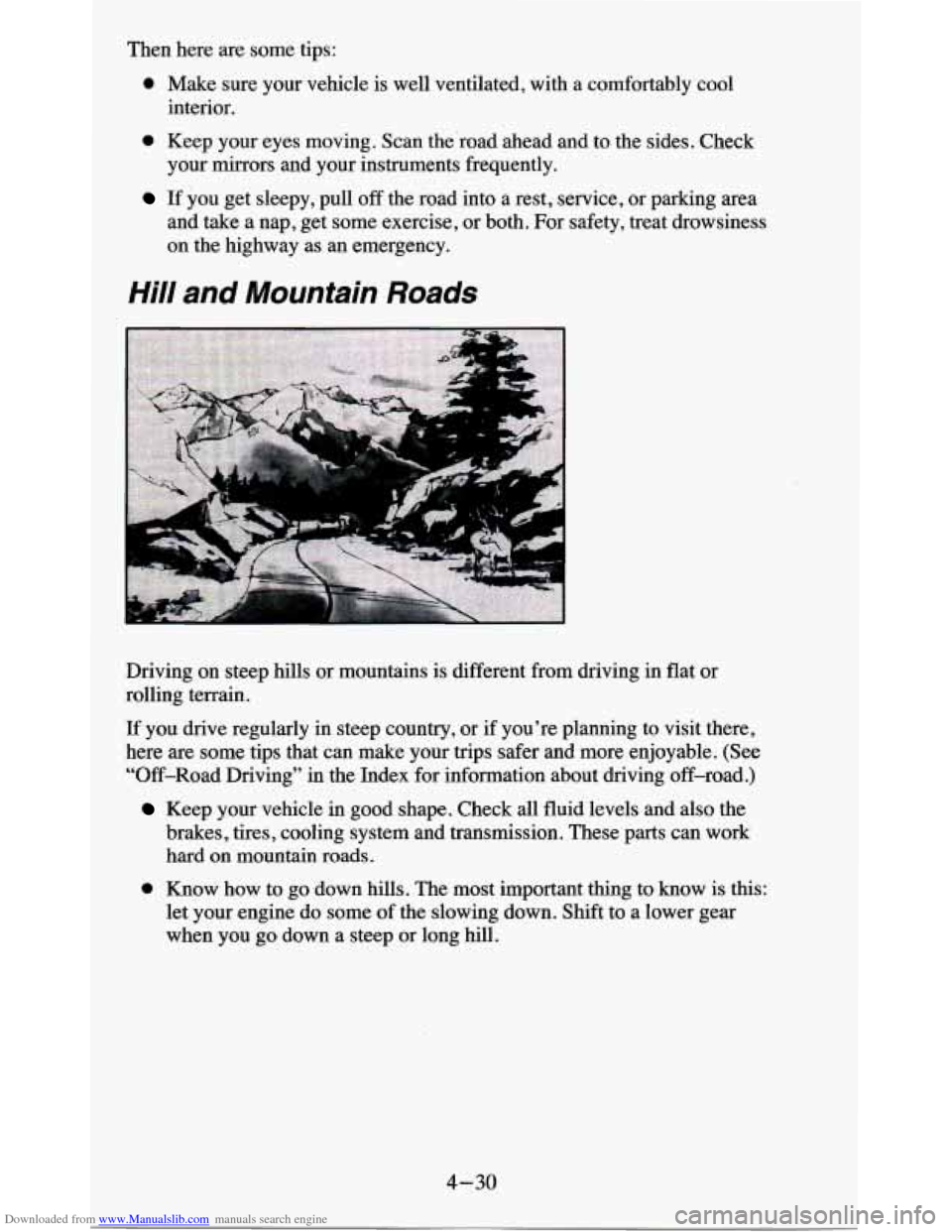
Downloaded from www.Manualslib.com manuals search engine Then here tire some tips:
0 Make sure your vehicle is well ventilated, with a comfortably cool
interior.
0 Keep your eyes moving. Scan the‘road ahead and to the sides. Check
your mirrors and your instruments frequently.
If you get sleepy, pull off the road into a rest, service, or parking area
and take a nap, get some exercise, or both. For safety, treat drowsiness
on the highway as an emergency.
Hill and Mountain Roads
Driving on steep hills or mountains is different from driving in flat or
rolling terrain.
If you drive regularly in steep country, or if you’re plann\
ing to visit there,
here are some tips that can make your trips safer and more enjoyable. (See \
“Off-Road Driving” in the Index for information about driving off-road.)
Keep your vehicle in good shape. Check all fluid levels and also the
brakes, tires, cooling system and transmission. These parts can work
hard on mountain roads.
0 Know how to go down hills. The most important thing to know is this:
let your engine do some of the slowing down. Shift to a lower gear
when you go down a steep or long hill.
4-30
Page 201 of 380
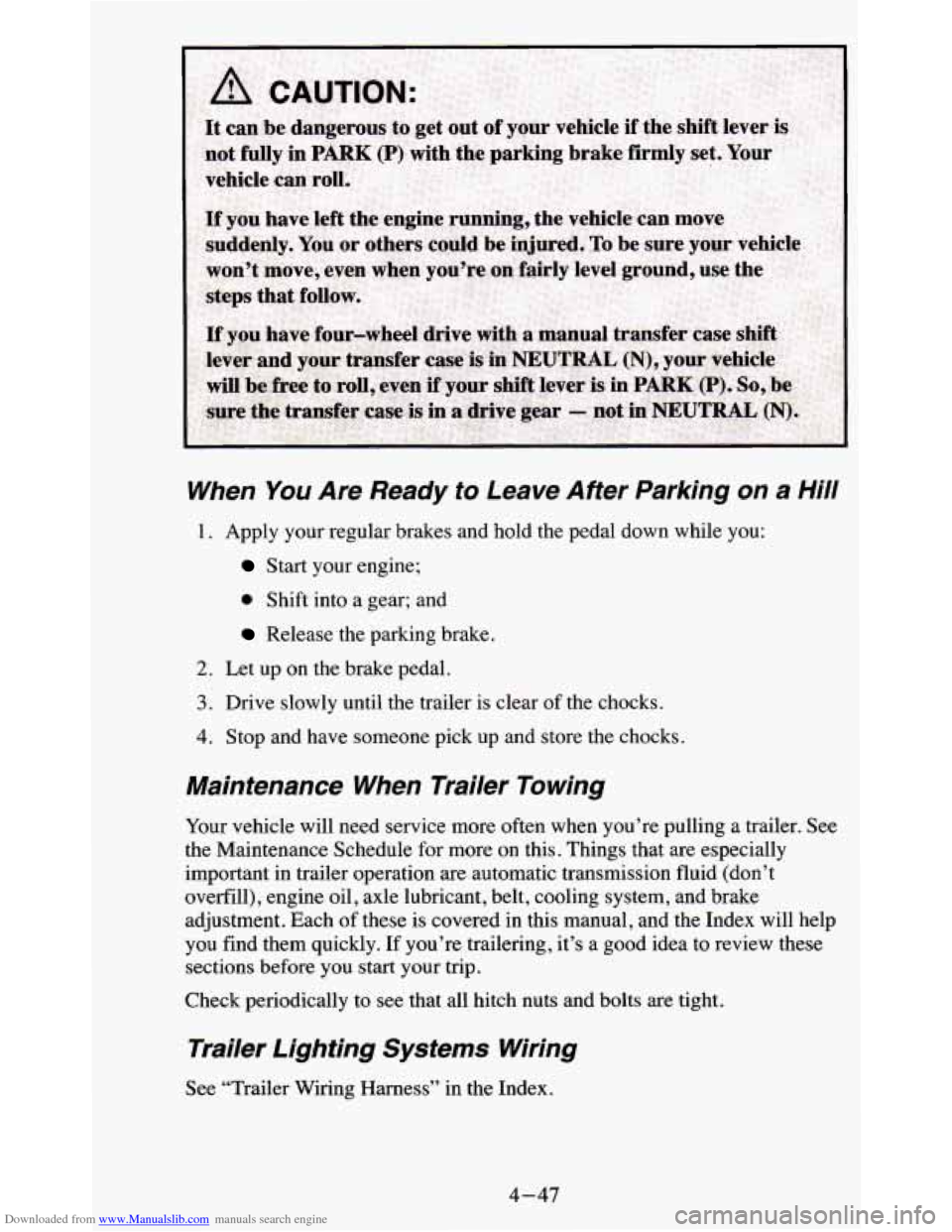
Downloaded from www.Manualslib.com manuals search engine When You Are Ready to Leave After Parking on a Hill
1. Apply your regular brakes and hold the pedal down while you:
Start your engine;
0 Shift into a gear; and
Release the parking brake.
2. Let up on the brake pedal.
3. Drive slowly until the trailer is clear of the chocks.
4. Stop and have someone pick up and store the chocks.
Maintenance When Trailer Towing
Your vehicle will need service more often when you’re pulling a trailer. See
the Maintenance Schedule for more on this. Things that are especially
important
in trailer operation are automatic transmission fluid (don’t
overfill), engine oil, axle lubricant, belt, cooling system, and brake
adjustment. Each
of these is covered in this manual, and the Index will help
you find them quickly. If you’re trailering, it’s a good idea to review these
sections before you start your trip.
Check periodically to see that all hitch nuts and bolts are tight.
Trailer Lighting Systems Wiring
See “Trailer Wiring Harness” in the Index.
4-47
Page 254 of 380
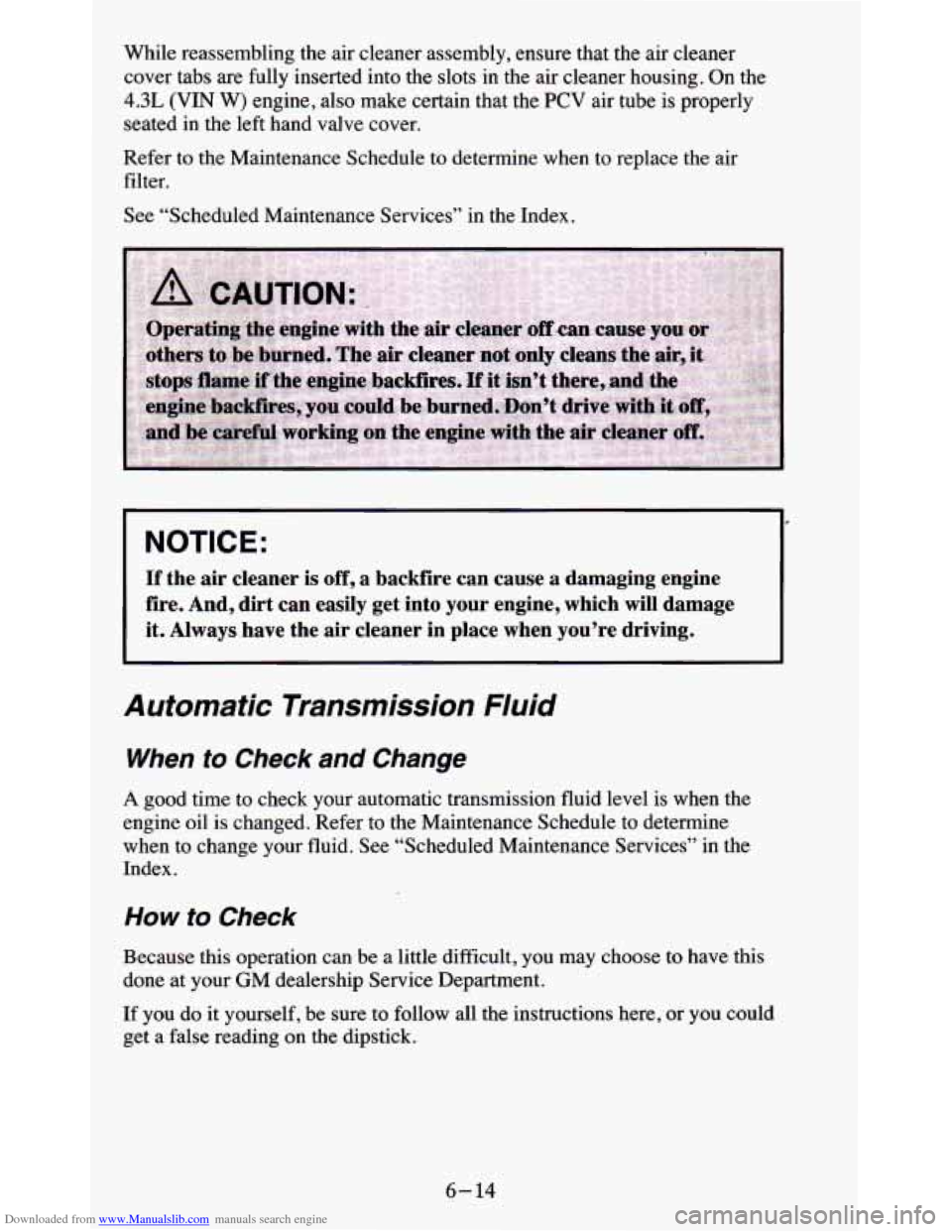
Downloaded from www.Manualslib.com manuals search engine While reassembling the air cleaner assembly, ensure that the air cleaner
cover tabs are fully inserted into the slots in the air cleaner housing. On the
4.3L (VIN W) engine, also make certain that the PCV air tube is properly
seated in the left hand valve cover.
Refer to the Maintenance Schedule to determine
when to redace the air
filter.
See “Scheduled Maintenance Services” in the Index.
NOTICE:
If the air cleaner is off, a backfire can cause a damaging engine
fire. And, dirt can easily get into your engine, which will d\
amage
it. Always have the air cleaner in place when you’re driving.
Automatic Transmission Fluid
-When to Check and Change
A good time to check your automatic transmission fluid level is when the
engine oil is changed. Refer to the Maintenance Schedule to determine
when to change your fluid. See “Scheduled Maintenance Services” in the
Index.
How to Check
Because this operation can be a little difficult, you may choose to have this
done at your GM dealership Service Department.
If you do it yourself, be sure to follow all the instructions here, or you could
get a false reading on the dipstick.
6- 14
Page 255 of 380
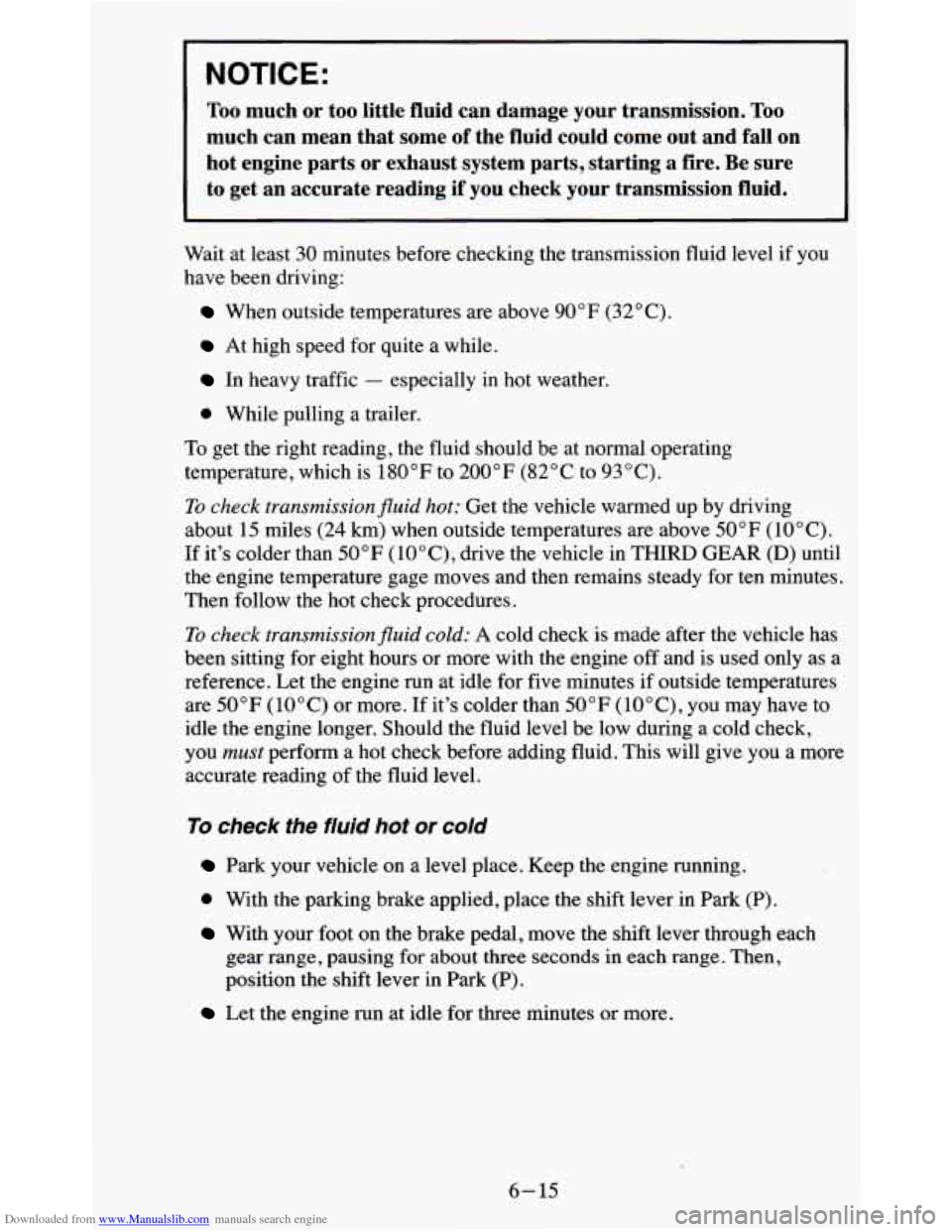
Downloaded from www.Manualslib.com manuals search engine NOTICE:
Too much or too little fluid can damage your transmission. Too
much can mean that some of the fluid could come out and fall on
hot engine parts or exhaust system parts, starting a fire. Be \
sure
to get an accurate reading if you check your transmission flui\
d.
Wait at least 30 minutes before checking the transmission fluid level if you
have been driving:
When outside temperatures are above 90°F (32°C).
At high speed for quite a while.
In heavy traffic - especially in hot weather.
0 While pulling a trailer.
To get the right reading, the fluid should be at normal operating
temperature, which is
180°F to 200°F (82°C to 93°C).
To check transmissionfluid hot: Get the vehicle warmed up by driving
about 15 miles (24 km) when outside temperatures are above 50°F
(10°C).
If it's colder than 50°F ( lO"C), drive the vehicle in THIRD GEAR (D) until
the engine temperature gage moves and then remains steady for ten minutes.
Then follow the hot check procedures.
To check transmissionfluid cold: A cold check is rnaae after the vehicle has
been sitting for eight hours or more with the engine
off and is used only as a
reference. Let the engine
run at idle for five minutes if outside temperatures
are
50°F (10°C) or more. If it's colder than 50°F (lO"C), you may have to
idle the engine longer. Should the fluid level be low during a cold check,
you
must perform a hot check before adding fluid. This will give you a more
accurate reading of the fluid level.
To check the fluid hot or cold
Park your vehicle on a level place. Keep the engine running.
0 With the parking brake applied, place the shift lever in Park (P).
With your foot on the brake pedal, move the shift lever through each
gear range, pausing
for about three seconds in each range. Then,
position the shift lever in Park (P).
Let the engine run at idle for three minutes or more.
6- 15
Page 257 of 380
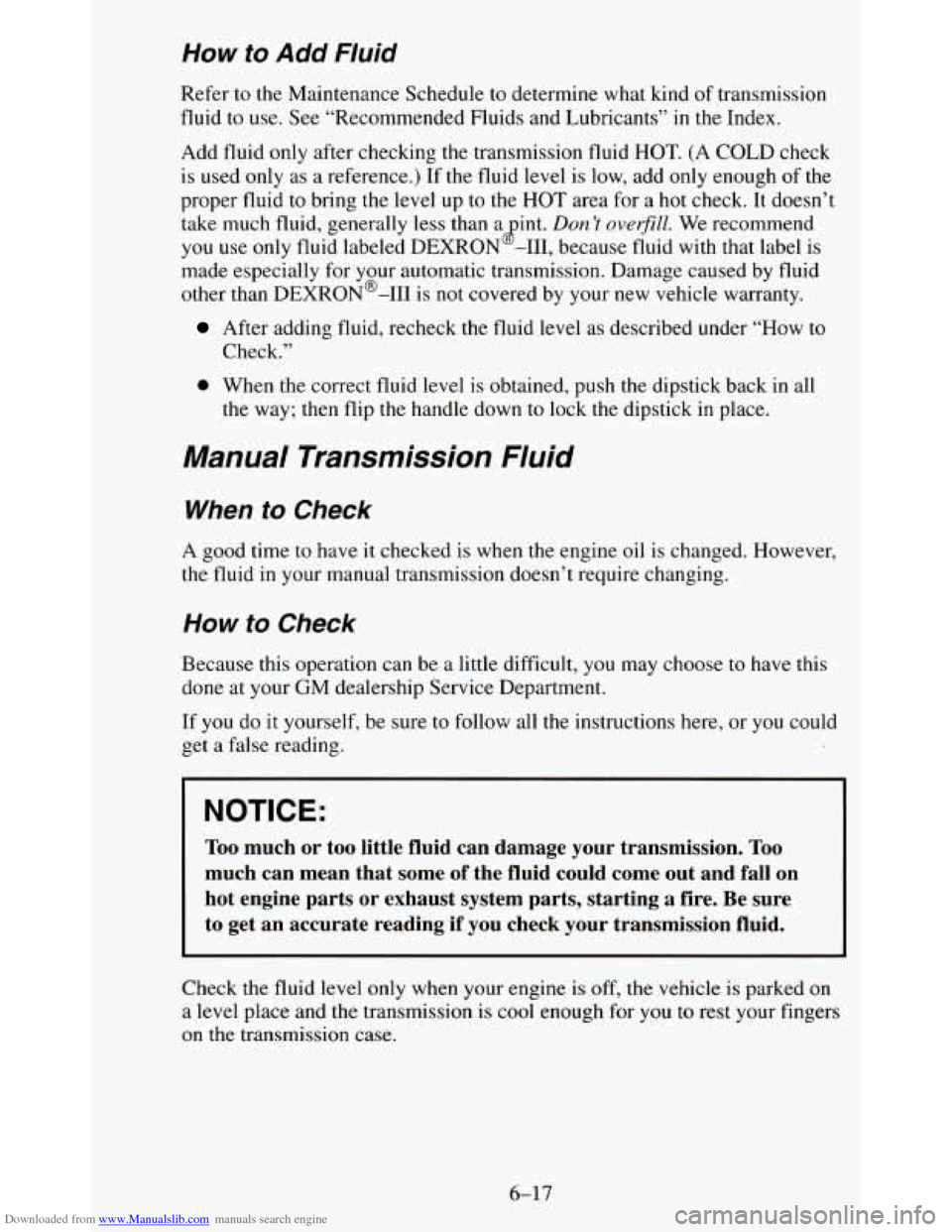
Downloaded from www.Manualslib.com manuals search engine How to Add Fluid
Refer to the Maintenance Schedule to determine what kind of transmission
fluid to use. See “Recommended Fluids and Lubricants” in the Index.
Add fluid only after checking the transmission fluid
HOT. (A COLD check
is used only
as a reference.) If the fluid level is low, add only enough of the
proper fluid to bring the level up to the
HOT area for a hot check. It doesn’t
take much fluid, generally less than a int.
Don ’t overfill. We recommend
you use only fluid labeled DEXRON -111, because fluid with that label is
made especially for your automatic transmission. Damage caused by fluid
other than DEXRON@-I11 is not covered by your new vehicle warranty. 8
After adding fluid, recheck the fluid level as described under “How to
Check.”
0 When the correct fluid level is obtained, push the dipstick back in all
the way; then flip the handle down to lock the dipstick in place.
Manual Transmission Fluid
When to Check
A good time to have it checked is when the engine oil is changed. However,
the fluid in your manual transmission doesn’t require changin\
g.
How to Check
Because this operation can be a little difficult, you may choose to have this
done at your GM dealership Service Department.
If you do it yourself, be sure
to follow all the instructions here, or you could
get a false reading.
I NOTICE:
Too much or too little fluid can damage your transmission. Too
much can mean that some of the fluid could come out and fall on
hot engine parts or exhaust system parts, starting
a fire. Be sure
to get an accurate reading if you check your transmission fluid.
Check the fluid level only when your engine is off, the vehicle is parked on
a level place and the transmission is cool enough for you to rest your fingers
on the transmission case.
6-17
Page 327 of 380

Downloaded from www.Manualslib.com manuals search engine I Maintenance Schedule I I
48,000 Miles (80 000 km)
0 Change engine oil and filter (or every 3 months, whichever occurs
0 Lubricate the front suspension, ball joints (ball joints should not be
first).
An Emission Control Service.
lubricated unless their
temperature is 10°F (-1 2°C) or higher. When
the weather is cold, let them warm up before lubricating them or they
could be damaged.), steering linkage and transfer case shift linkage,
parking brake cable guides, propshaft splines, universal joints, brake
pedal springs, and clutch pedal springs at every oil change (or every
6
months, whichever occurs first).
constant velocity joints and axle seals for leaking.**
Check readfront axle fluid level and add fluid as needed. Check
DATE ACTUAL MILEAGE SERVICED BY:
L
50,000 Miles (83 000 km)
0 Change automatic transmission fluid and filter if the vehicle is mainly
driven under one or more of these conditions:
- In heavy city traffic where the outside temperature regularly
reaches
90 OF (32 O C) or higher.
- In hilly or mountainous terrain.
- When doing frequent trailer towing.
- Uses such as found in taxi, police car or delivery service.
If you do not use your vehicle under any of these conditions, the fluid
and filter do not require changing.
Manual transmission fluid doesn’t require change.
I DATE I ACTUALMILEAGE I SERVICED BY: I
7- 15
Page 337 of 380
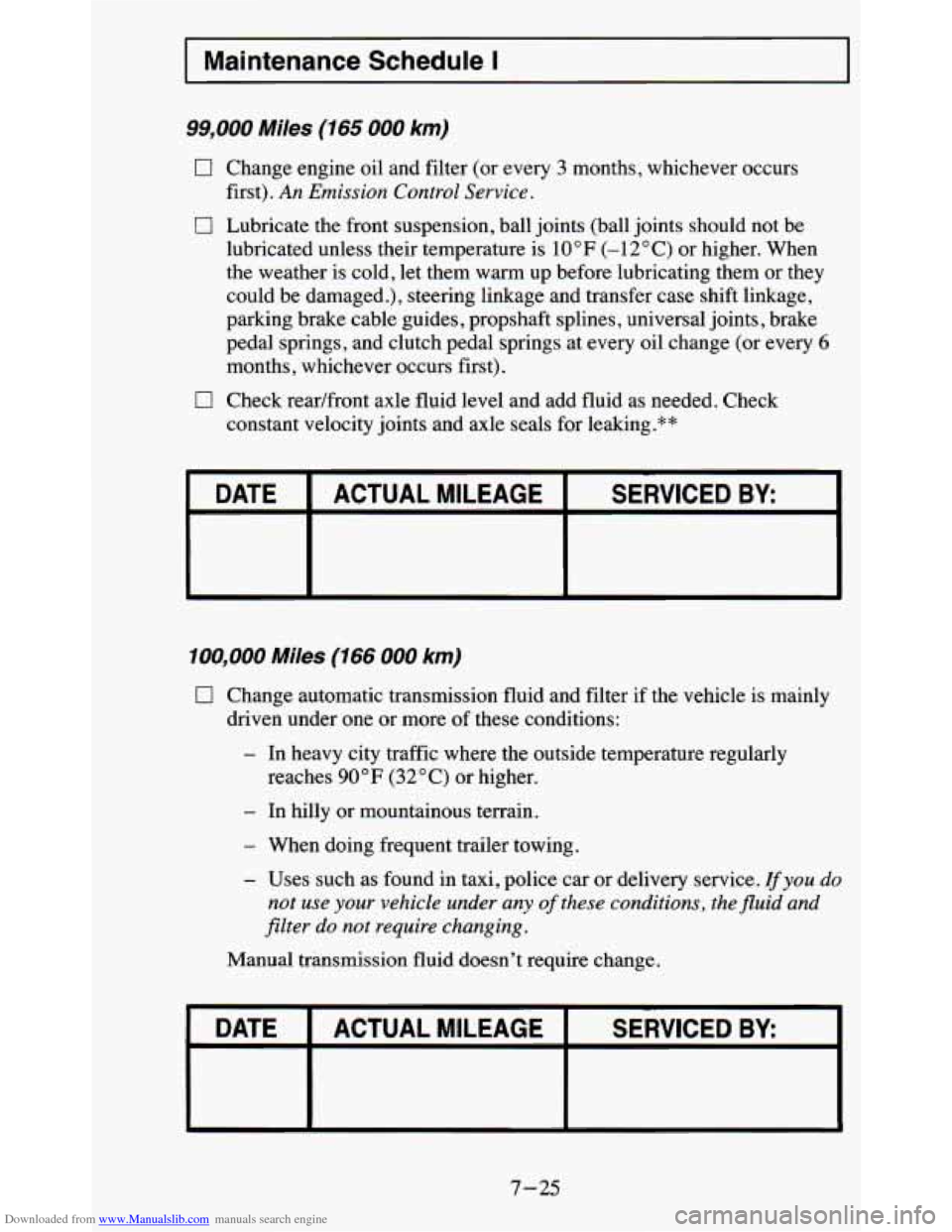
Downloaded from www.Manualslib.com manuals search engine Maintenance Schedule I
99,000 Miles (165 000 km)
0 Change engine oil and filter (or every 3 months, whichever occurs
0 Lubricate the front suspension, ball joints (ball joints should not be
first).
An Emission Control Service.
lubricated unless their
temperature is 10 "F (-1 2°C) or higher. When
the weather is cold,
let them warm up before lubricating them or they
could be damaged.), steering linkage and transfer case shift linkage,
parking brake cable guides, propshaft splines, universal joints, brake
pedal springs, and clutch pedal springs at every oil change (or every
6
months, whichever occurs first).
0 Check readfront axle fluid level and add fluid as needed. Check
constant velocity joints and axle seals for leaking.**
DATE
SERVICED BY ACTUAL MILEAGE
100,000 Miles (166 000 km)
0 Change automatic transmission fluid and filter if the vehicle is mainly
driven under one or more of these conditions:
- In heavy city traffic where the outside temperature regularly
reaches
90°F (32°C) or higher.
- In hilly or mountainous terrain,
- When doing frequent trailer towing.
- Uses such as found in taxi, police car or delivery service. Ifyou do
not use your vehicle under any of these conditions, the fluid and
filter
do not require changing.
Manual transmission fluid doesn't require change.
DATE
SERVICED BY ACTUAL MILEAGE
L
7-25
Page 342 of 380

Downloaded from www.Manualslib.com manuals search engine 50,000 Miles (83 000 km)
0 Change automatic transmission fluid and filter if the vehicle is mainl\
y
- In heavy city traffic where the outside temperature regularly
driven under
one or more of these conditions:
reaches
90°F (32°C) or higher.
- In hilly or mountainous terrain.
- When doing frequent trailer towing.
- Uses such as found in taxi, police car or delivery service.
If you do not use your vehicle under any of these conditions, the fluid
and filter
do not require changing.
Manual transmission fluid doesn’t require change.
52,500 Miles (87 500)
0
0
0
Change engine oil and filter (or every 12 months, whichever occurs
first).
An Emission Control Service.
Lubricate the front suspension, ball joints (ball joints should not be
lubricated unless their temperature is
10°F (-12°C) or higher. When
the weather is cold, let them warm up before lubricating them or they
could be damaged.), steering linkage and transfer case shift linkage,
parking brake cable guides, propshaft splines, universal joints, brake
pedal springs, and clutch pedal springs at every oil change (\
or every 12
months, whichever occurs first).
Check readfront axle fluid level and add fluid as needed. Check
constant velocity joints and axle seals for leaking.**
Rotate tires. See “Tire Inspection and Rotation” in the Index for proper
rotation pattern and additional information.
DATE SERVICED BY: ACTUAL MILEAGE I
7-30
Page 347 of 380
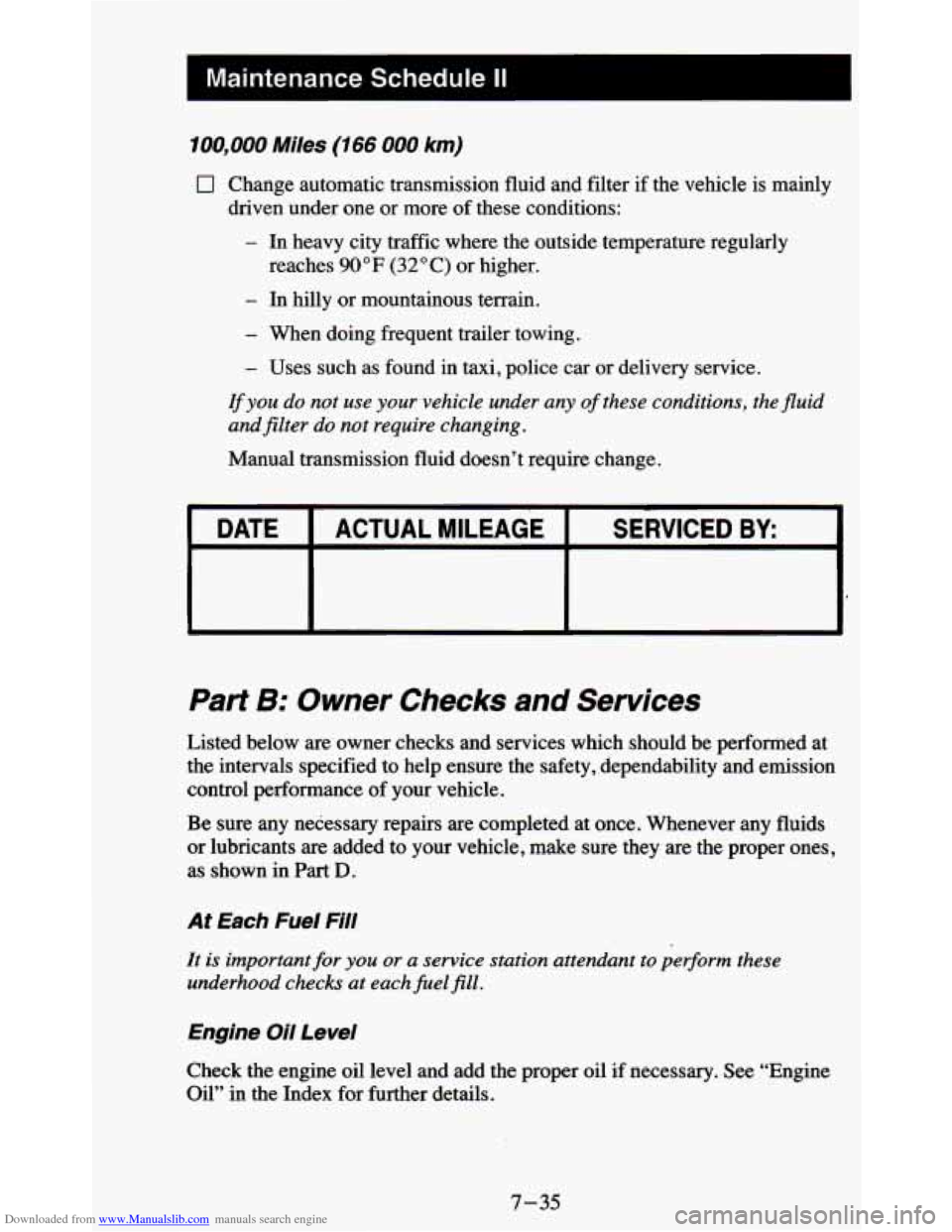
Downloaded from www.Manualslib.com manuals search engine I Maintenance Schedule II
700,000 Miles (766 000 km)
0 Change automatic transmission fluid and filter if the vehicle is mainly
- In heavy city traffic where the outside temperature regularly
driven under
one or more
of these conditions:
reaches
90 OF (32 O C) or higher.
- In hilly or mountainous terrain.
- When doing frequent trailer towing.
- Uses such as found in taxi, police car or delivery service.
IJ you do not use your vehicle under any of these conditions, the fluid
and filter do not require changing.
Manual transmission fluid doesn’t require change.
DATE
SERVICED BY: ACTUAL MILEAGE I
Part B: Owner Checks and Services
Listed below are owner checks and services which should be performed at
the intervals specified to help ensure the safety, dependability and emission
control performance
of your vehicle.
Be sure any necessary repairs are completed at once. Whenever any fluids
or lubricants are added to your vehicle, make sure they are the proper ones,
as shown
in Part D.
At Each Fuel Fill
It is important for you or a sewice station attendant to perform these
underhood checks at each @el
fill.
Engine Oil Level
Check the engine oil level and add the proper oil if necessary. See “Engine
Oil” in the Index for further details.
7-35